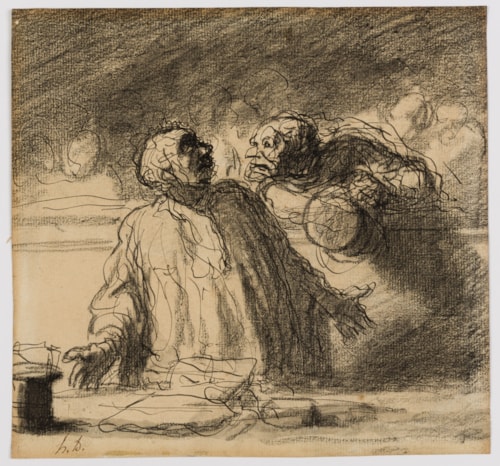
Honoré DAUMIER
Marseille 1808 - Valmondois 1879
Biography
Born in Marseille but raised in Paris, Honoré Daumier was almost never to leave the city, and made its people the subject of much of his work. Although he attended life drawing classes at the Académie Suisse, he had little formal artistic training and was, for the most part, self-taught. He began his career as an illustrator and lithographer, providing images and political caricatures for newspapers and magazines such as La Silhouette, La Caricature and, most famously, Le Charivari. He soon established a formidable reputation as a caricaturist. Over the course of his life, Daumier produced over four thousand lithographs and some eight hundred drawings and watercolours. The drawings were mainly done during periods in his career – in the late 1840s and early 1850s, and again in the 1860s - when the artist’s time was not completely devoted to his commercial work as a lithographer. In the 1860s, for example, when he was temporarily laid off by Le Charivari, Daumier produced a number of highly finished and elaborate watercolours to be sold to collectors.
As a draughtsman, Daumier tended to depict a handful of favourite themes, notably carnival performers, women and children, people on trains and in railway stations, and the law courts. Working in chalk, charcoal, watercolour, pen and ink and wash, he created both finished drawings and watercolours for sale, as well as sketches or studies and quick ‘notes’. As the critic Claude Roger-Marx wrote of the artist, ‘When Daumier drew to please himself and without thought of a purchaser, it was nearly always with the pen or with charcoal; sometimes with a Conté crayon, very seldom with a lead pencil. To an expansive genius, driven by the power of his imagination, charcoal gives the greatest scope, enabling him to pass in an instant from the most velvety black to silvery grey, to stress contrasting values, to make the most of the qualities of shimmering light which transform the charcoal powder into a modest form of pastel…The pen in Daumier’s inspired fingers was no less rapid: we may follow its course across the surface of the smooth laid paper which he used for choice. It runs lightly, leaving furrows as though seared by fire, and, like the charcoal, it never fails to achieve a miracle...’ Daumier’s drawings are very rarely dated and are often unsigned, and only a very few were exhibited in his lifetime.



